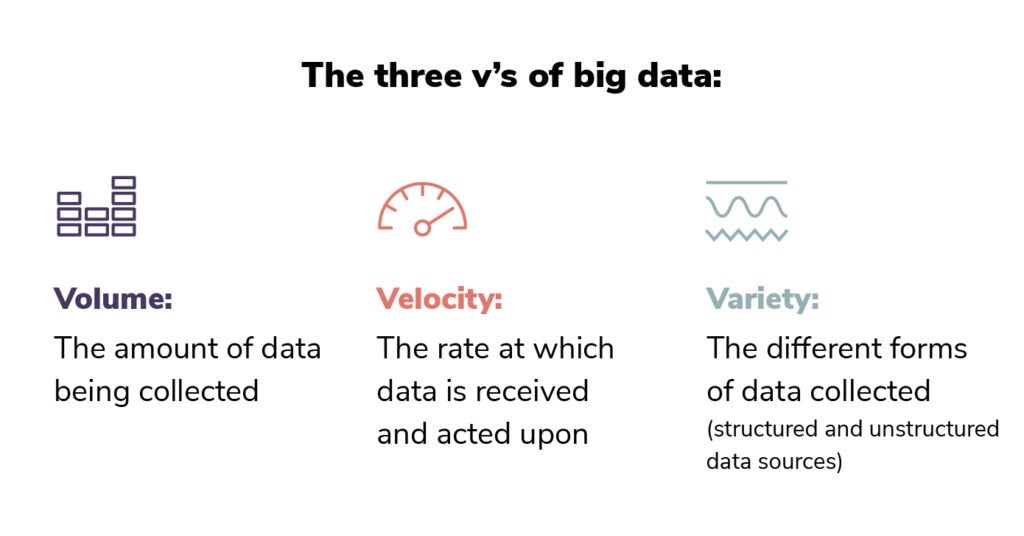This article was originally published at Algorithimia’s website. The company was acquired by DataRobot in 2021. This article may not be entirely up-to-date or refer to products and offerings no longer in existence. Find out more about DataRobot AI Platform here.
The big data industry has grown at an incredible rate as businesses realize the importance of insightful data analysis. But what exactly is big data, and how does it correspond to artificial intelligence? We will compare the two realms, what they are, their differences, and how the combination of both leads to results beyond traditional human capability.
What are big data and artificial intelligence?
Big data
Big Data is a field focused on managing large amounts of data from a variety of sources. Big data comes into play when the volume of data is too large for traditional data management practices to be effective. Companies have long collected massive amounts of information about consumers, pricing, transactions, and product security, but eventually the volume of data collected proved too much for humans to manually analyze.

The essence of big data can be broken into “the three v’s of big data”:
- Volume: The amount of data being collected
- Velocity: The rate at which data is received and acted upon
- Variety: The different forms of data collected, (structured and unstructured data sources)
Artificial intelligence
Artificial intelligence (AI) is the development and implementation of computer systems that are capable of logic, reasoning, and decision making. This self-learning technology uses visual perception, emotion recognition, and language translation to analyze data and output information in a more efficient manner than human-driven methods.
In fact, you likely already interact with AI systems on a daily basis. The largest companies in the world, such as Amazon, Google, and Facebook, use artificial intelligence in their user interfaces. AI is what powers personal assistants like Siri, Alexa, and Bixby, and allows websites to recommend products, videos, or articles that might interest you. These targeted suggestions aren’t a coincidence, they are a result of artificial intelligence.
What is the difference between big data and artificial intelligence?
The difference between artificial intelligence and big data lies in the output of each. Artificial intelligence analyzes inputs to learn and improve its sorting or patterning processes over time, using data that it gathers to provide a more accurate diagnostic.

In contrast, big data is the overarching pool of information that is accumulated from various data sources, to then be analyzed by artificial intelligence. Big data and artificial intelligence are often used in conjunction with one another, but each fulfill very different roles, one is information and the other is a treatment of that information.
How big data and artificial intelligence work together
Big data and artificial intelligence are interdependent. Although each discipline is distinct, the presence of each is crucial in allowing for the other to function at its highest degree. AI does use data, but its ability to analyze and learn from this data is limited by the quantity of information that is fed into the system. Big data provides a vast sample of this information, making it the gas that fuels top-end artificial intelligence systems.
By harnessing big data resources, artificial intelligence systems can make more informed decisions, provide better user recommendations, and find ever-improving efficiencies in your models. However, an agreed-upon ruleset for data collection and data structure must be in place prior to AI implementation to ensure production of the best data possible.
Some benefits of AI and big data:
- Less labor-intensive data analytics
- Machine learning helps to relieve common data problems
- Doesn’t lessen the importance of humans in the analytic process
- More predictable and prescriptive analytics
Algorithmia understands big data and AI challenges
The world of big data and artificial intelligence can be overwhelming, but these processes are crucial for enterprises to have in place to stay competitive. However, implementation of effective systems comes with its own set of challenges. Algorithmia understands these needs and hosts a serverless microservices architecture that allows enterprises to easily deploy and manage machine learning models at scale.
Related posts
See other posts in AI for PractitionersLearn how to build and scale agentic AI with NVIDIA and DataRobot. Streamline development, optimize workflows, and deploy AI faster with a production-ready AI stack.
What is an AI gateway? And why does your enterprise need one? Discover how it keeps Agentic AI scalable, secure, and cost-efficient. Read the full blog.
Explore syftr, an open source framework for discovering Pareto-optimal generative AI workflows. Learn how to optimize for accuracy, cost, and latency in real-world use cases.
Related posts
See other posts in AI for PractitionersGet Started Today.